April 2021 Newsletter

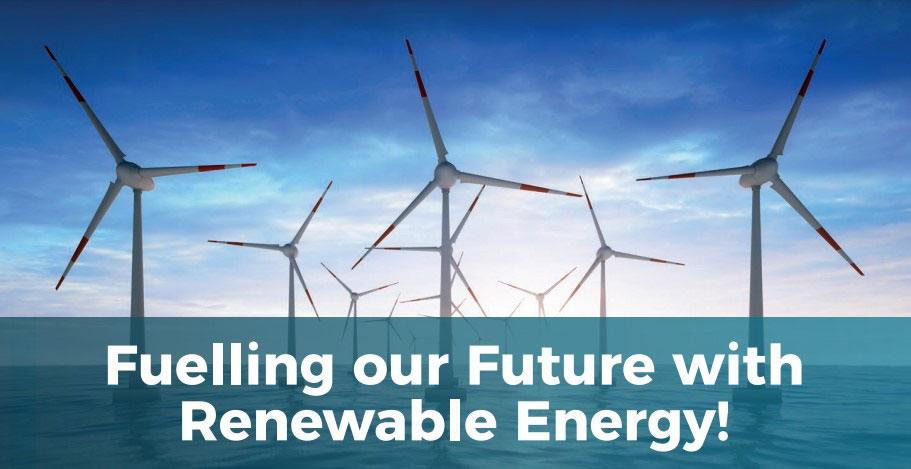
Welcome to our first newsletter of 2021, which focuses on exciting advances in the offshore renewable energy sector. Industries and governments across the globe are planning to achieve net-zero carbon commitments, with offshore wind being a natural choice for many.
The UK government alone has projected 30% of power will be supplied by offshore wind by 2040. A hugely ambitious target of 75 GW installed capacity by 2050 is up from ~11 GW in 2020. This optimistic, but fully achievable aspiration will capitalise on the UK’s world-leading position in offshore renewable energy. RIL is proud to be the UK’s leading marine geophysical consultancy in this sector, well placed to make significant contributions in the coming years of change.
While the global pandemic of 2020 was a dreadful year for many in terms of social and economic impacts, RIL have undergone considerable growth to respond effectively to a substantially increased specialist workload. In March 2020 we expanded into another office suite in our current building, effectively doubling our floor space (very useful for social distancing!).
Between May last year and January this year we expanded from six staff to 13, including two with specialisms in engineering and environmental geophysics. We also recruited a Post-Doctoral Research Associate to help with our expanding international geohazards projects and R&D. The remaining new recruits have joined our marine geophysics team working on offshore wind farm developments around the world. With the fresh challenges ahead, we anticipate doubling our turnover this year compared with last.
UK Offshore wind leasing Round 4
The results are in! The winners of the Round 4 offshore wind leasing round bidding organised by the Crown Estate have been announced for the four main geographical regions in coastal waters around England and Wales:
- North Sea
- Southern North Sea
- English Channel
- Irish Sea Zone
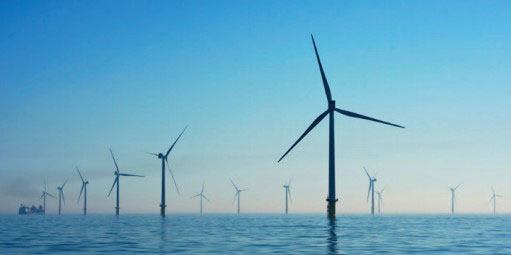
Six proposed projects totalling 8 GW of installed capacity have been accepted. Oil and gas giant BP outbid its competitor Shell and, in partnership with German energy firm EnBW are the preferred developers for 3 GW in the Irish Sea Zone.
RWE, Germany’s largest power producer, is the confirmed developer for another 3 GW. It is already developing Awel y Môr as an extension to the existing Gwynt y Môr off the North Wales coast. France’s oil giant Total has combined with Macquarie’s Green Investment Group for a 1.5 GW development off the East Anglian coast.
The remaining project, 480 MW, was awarded to Offshore Wind Ltd, a venture of Cobra Instalaciones y Servicios and Flotation Energy.
Reynolds International Ltd has had extensive experience in the southern North Sea for more than a decade as well as in the Irish Sea Zone (see the news stories on pages 2 and 3). We are, therefore, exceptionally well placed to help OWF developers in Round 4. We have a proven track record in managing the data journey from concept, ground investigation strategy, through survey planning, and in- and postsurvey Quality Control, to providing high-quality robust 3D geological Ground Models. These enable clients to save significant amounts of money by reducing their overall ground investigation and foundation design costs.
Shallow gas as a geohazard
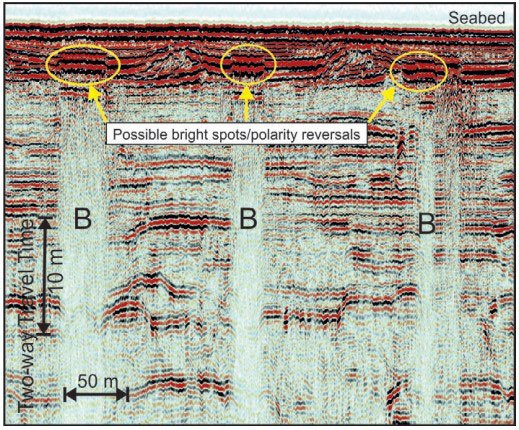
Without the right type of investigation data, subsurface hazards such as shallow gas, boulders, and unexploded ordnance, can remain concealed. Avoiding such hazards allows for safer wind turbine foundation installations and may also reduce costs. A combination of seismic and geotechnical data is fundamental to aid our understanding of the subsurface geology; it also helps developers to make the best decisions for offshore wind turbine site development and foundation design.
Once a wind farm development area has been identified via economic, environmental, and meteorological studies, the next crucial step is to understand the subsurface geology and identify whether any possible geohazards might be present. This understanding can be gained via rigorous interrogation and interpretation of geophysical, geological, and geotechnical data, with significant emphasis on the acquisition, processing, and interpretation of Ultra-High Resolution, singleand multi-channel seismic reflection data.
Mapping the subsurface geology is critical to the planning and placement of wind turbines. However, seismic data are also key in the identification of subsurface geohazards. The seismic section shown displays evidence for possible shallow gas accumulations within near-surface sediments. If drilled into, the gas may combust or suddenly discharge through the seabed thereby destabilising it with extremely serious implications for jack-up rigs. Shallow gas can be identified on seismic data by areas of poorly illuminated reflections, polarity reversals, flat or bright spots (indicated on the section) where the gas accumulates beneath capping materials, or as seafloor pock marks that might also be evident on Multi-Beam Echo Sounding and Side-Scan Sonar mosaics. The presence of gas affects the speed at which seismic (sound) waves travel and slows them down. This causes changes in the character of the seismic data across materials containing gas. Subsequent deeper lithological interfaces or features are much more difficult to distinguish due to these changes (often referred to as ‘acoustic blanking’, ‘B’ on the seismic section), which creates greater uncertainty in the overall seismic interpretation.
Geophysicists at Reynolds International have an abundance of experience in identifying these and other geohazards. Identification and avoidance of geohazards significantly reduces the possible occurrence of major health and safety or environmental disasters. Therefore, acquiring, processing, and interpreting seismic data thoroughly are key steps in offshore wind farm site development.
Award of major OWF contract by Scottish Power Renewables
ScottishPower Renewables (SPr) is proposing to construct its future offshore windfarms, East Anglia THREE, East Anglia TWO and East Anglia ONE North, as a new ‘East Anglia Hub’. The East Anglia Hub would comprise up to 263 next generation turbines in the southern North Sea generating up to 3.1GW. In support of this, RIL is delighted to announce that it has been awarded a major contract by SPr to develop and refine 3D geological Ground Models for each of these three offshore wind farm (OWF) projects and their associated Export Cable Corridors through until 2022. The total work is the equivalent of developing detailed 3D geological Ground Models for 13 OWF site areas over two years.
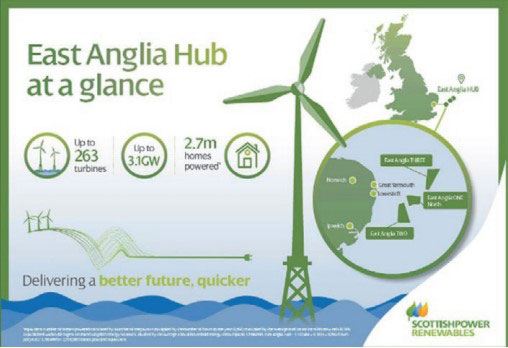
This contract award is the culmination of ten years’ of working with SPr on the East Anglia Zone. The northern part of the area was subsequently taken over by Vattenfall who are currently developing several OWFs there and for which RIL undertook pioneering early-stage geophysical exploration interpretation as well as for SPr. Still within the southern North Sea, RIL has also undertaken multiple other OWF projects in Dutch and Belgian waters. Overall, RIL has worked on over 50 projects related to OWFs in UK and European, Asian, and US waters over the last 10 years, compounding RIL’s reputation as being the UK’s leading renewable energy marine geophysics consultancy.
Exploring a submerged glacial landscape off North Wales

When RIL was engaged by Celtic Array Ltd (CAL) in 2012 to work on the Round 3 Rhiannon Offshore Wind Farm in the Irish Sea Zone, little did we realise the journeyn of exploration into the unknown that was to follow. The only previous comprehensive investigations had been undertaken by the then Institute of Geological Sciences (now the British Geological Survey) back in the 1970s.
Once we had started to process and interpret the high-resolution seismic reflection data collected by CAL, it became clear that we were unravelling a subsurface environment at a scale not previously seen. In addition, the detailed geotechnical sampling and testing with boreholes gave a much greater insight into the characteristics of the material present that was being imaged by the seismic surveys.
An example profile is shown here on which the interpreted top of bedrock, Undifferentiated Carboniferous units (including Coal Measures), is shown by the blue line. Inclined reflections (lower right) are associated with coal seams and are faulted (black lines). A light blue line denotes the boundary between what appears on the seismic sections as a darker pattern of reflections below and lighter above.
From the geotechnical testing it was found that the material represented by the darker patterns was over-consolidated glacial till. That associated with the shallower material was found to be normally consolidated probably glacio-fluvial sediments. The seismic expression of the topography shown by the blue line indicates a seismic morphology indicative of the bedrock being overlain by glacial deposits, notably drumlins and ribbon moraines. This was a palaeo glacial landscape more akin to present day Greenland ice sheet margins, with melting glaciers feeding rivers that flow out in braided channels with isolated shallow lakes, as sea level at the time of deposition was much lower than it is today.
This area of the Irish Sea is now part of the Round 4 Leasing area being managed by The Crown Estate (see p2). RIL has gained valuable experience of investigating the seafloor and sub-seabed geology across this area and is therefore extremely well placed to assist companies looking to develop OWF projects within this Round 4 area.
Award of major contract for Dutch OWF project
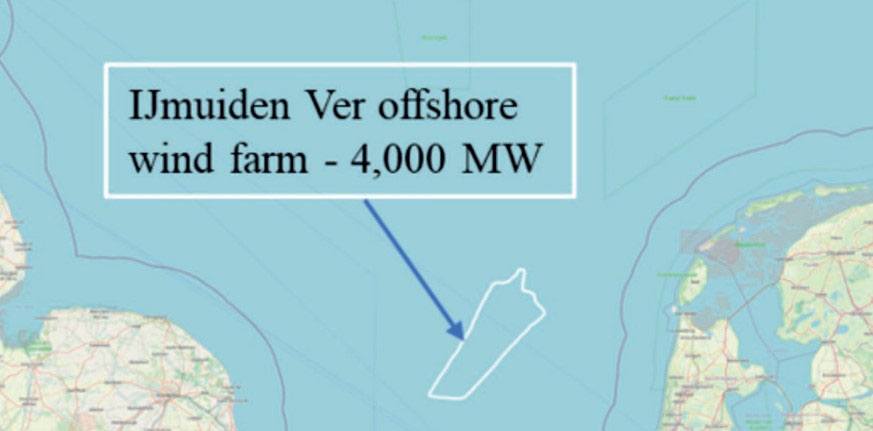
In 2020 Reynolds International Limited (RIL) were appointed by RVO in the capacity of geophysical expert sub-consultants to international offshore wind consultants BLIX. RVO is the Netherlands Enterprise Agency, a branch of the Ministry of Economic Affairs and Climate
Policy in the Dutch Government. Our remit has been to provide geophysical expertise and project management for the 4 GW Ijmuiden Ver (IJV) Offshore Wind Farm.
Drawing on our expertise on the general site conditions and the geological and geophysical characteristics of the southern North Sea, we are well suited to provide the best advice possible to support the progress of the IJV project. Key contributions being made by RIL include: onshore QC of sample data; review of deliverables such as reports, GIS, hydrographic, geological, and geophysical data; support in transferring results of the geophysical surveys to an integrated ground model; support in disclosing deliverables to relevant personnel; and support in project management.
We continue to provide regular expert support via virtual meetings and data reviews to key stakeholders involved with both the Preliminary and Integrated Ground Models (PGM, IGM, respectively). Recent examples of our contribution include advising and providing feedback to the PGM team on seismic data processing and interpretation. Additionally, we have advised on the processing and application of magnetic, bathymetric, and other hydrographic and geophysical data to inform the selection of the most suitable sites to place cone penetration tests. The results of these will allow further refinement of the IGM, which will provide greater certainty across the OWF project.
Marine Geophysics for Offshore Structures course
RIL have developed a one-day corporate workshop titled ‘High-resolution Marine Geophysical Investigations for Offshore Structures’. This unique course is essential for anyone working on offshore wind farm developments in a project management, technical engineering, or geotechnical capacity.
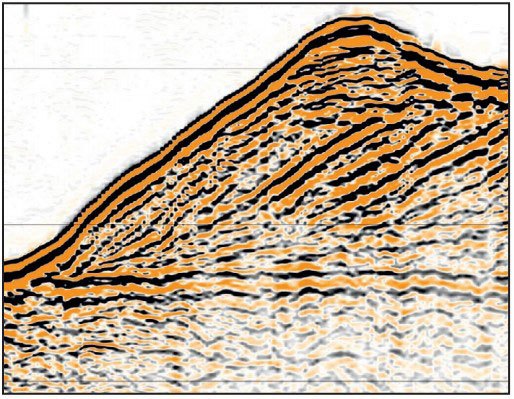
This course has been endorsed formally by the Geological Society, this course and is worth 6 hrs CPD for each delegate. The course material is updated regularly to reflect latest changes in technology and procedures. It can be modified to suit different geographical regions around the world (i.e., in relation to appropriate local regulations and standards), and tailored to an individual client’s needs.
The course is presented by Professor John M. Reynolds, author of the acclaimed geophysics textbook ‘An Introduction to Applied and Environmental Geophysics’, and internationally-sought-after speaker.
He has over 44 years’ experience of near-surface geophysics and has extensive recent experience of the offshore wind industry internationally. Previous delegates’ responses to this course presentation have returned overwhelming ‘excellent’ grades for content, notes, presenter, and overall.
Under prevailing Covid-19 conditions, a suitably modified version of the course can be provided virtually by arrangement.
Senior Adviser to The World Bank
Staff at RIL are both honoured and delighted at being appointed to the role of Senior Adviser to The World Bank (TWB), USA, on developing a project on transboundary management of geohazards and Disaster Risk Management for a major new initiative focussed on Nepal.
Prof. John M. Reynolds, MD at RIL, has been working in Nepal for over 27 years and is the independently acknowledged world expert on glacial hazards as well as pioneering and undertaking Integrated Geohazard Assessments for the hydropower sector. This appointment started in 2020 and is due to continue through to mid-2022.
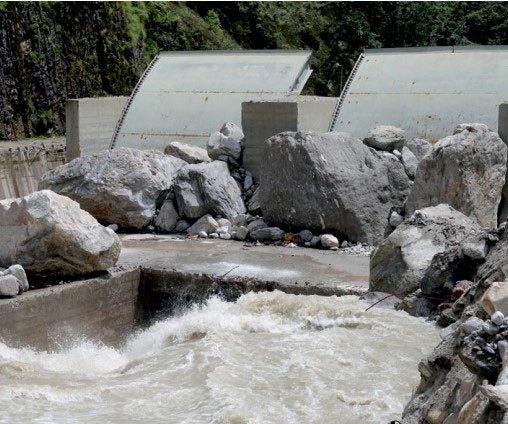
The main project to be undertaken by the appointed consultants is to develop a Roadmap to help advise on the development of a Disaster Risk Management Action Plan for a cascade of five hydropower schemes along the Arun River in Nepal. The bulk of the catchment for this river lies within Tibet, flows south through Nepal, into northern India, and through Bangladesh to the Bay of Bengal.
In addition to the technical elements of the project, there is also a requirement to identify suitable diplomatic channels through which the four partner countries can share technical data and help manage the risks arising from the geohazards identified, particularly in the upper reaches of the river system. Ultimately, once a full DRM Action Plan is operational, it should help to increase the resilience of these five hydropower schemes to the impacts of climate change and related geohazards.
Geo-Factoid – Large earthquakes within the last 3 months
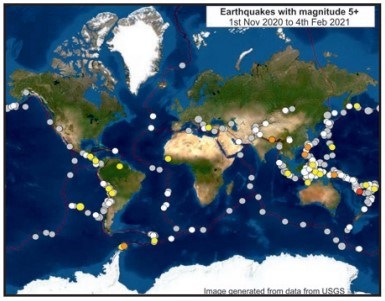
The epicentres of earthquakes with magnitudes of 5+ are shown on the map as dots; tectonic plate boundaries are indicated by solid lines. According to the USGS, there were 372 events between 1st November 2020 and 4th February 2021, equivalent to almost four significant earthquakes a day; there were hundreds more smaller events too.
There are clusters of large earthquakes in Central America, along the west side of Chile and Peru, and particularly around the western part of the so-called ‘Ring of Fire’ around the Pacific. These are predominantly related to the movement of tectonic plates at their boundaries and, in places, active volcanicity. We certainly live on a dynamic planet!
Reduce your project risks and save money with our specialist services
As the UK’s leading independent marine geophysics consultants for the OWF sector, our extensive services include but are not limited to the following:
- Ground Investigation multi-phase strategy
- Detailed design of geophysical and hydrographic surveys
- Generate ‘Expected Condition Sheets’ – unique to Reynolds International Ltd
- Back-office support during hydrographic and geophysical surveys
- QA/QC of hydrographic and geophysical contractors’ data and reports
- High-level analysis of seismic data
- Single- and multi-channel seismic data processing review
- High-level seismic data processing and specialist analytical analyses
- Single and 2D/3D multi-channel seismic interpretation
- Development of 3D geological Ground Models
- Recommendations for locations of intrusive tests
- Integration between geotechnical and geophysical interpretations
- Access to the results from the use of our bespoke proprietary imagis™ workflow
- And more besides
Contact us for more information about any or all the above.
Top 5 Tips for OWF Ground Investigation (GI) Strategy
We’ve been involved in OWF developments for more than a decade, and with over 60 OWF projects to our name. That’s why we know how to deliver exactly what is required and the quality needed, ensuring your OWF project completes on time. What’s more, we can save you 10-15% of GI costs.
- Determine your technical objectives for your OWF project site from the outset.
- Establish a clear overarching multi-phase Ground Investigation Strategy.
- Ensure each stage of your GI is sequenced appropriately.
- Design your geophysical and geotechnical GI to yield the results you need when you need them.
- Ensure the quality of your data is sufficient for and at every stage in the OWF development process.
Watch out for more details on each of these topics in our subsequent newsletters.
